 Vijay Kadam at his MACS 6478 wheat variety field. (Express Photo by Anuradha Mascarenhas)
Vijay Kadam at his MACS 6478 wheat variety field. (Express Photo by Anuradha Mascarenhas)
Vijay Kadam cannot forget wading through knee-deep water with his wife Rani last July in their flooded one-acre farm at Sastevasti village of Pune district’s Baramati tehsil.
“We were trying to salvage the seeds of the soyabean sown earlier that month. It was a futile effort,” recalls the 44-year-old. The silver lining was, however, MACS 6478, a wheat variety bred by the Agharkar Research Institute (ARI) under the Department of Science & Technology, Government of India.
“I had planted 40 kg of its seeds in the 2018 winter. The 28 quintals wheat that I harvested from them in April helped me make ends meet and also undertake some repair work at my home,” says Kadam, who has sown another 40 kg seeds of the variety in November.
He is confident of recouping the losses from his failed soyabean crop: “Not only was my wheat yield good, it also fetched me a rate of Rs 2,100 per quintal (more than the government’s minimum support price of Rs 1,840). The buyers were mostly farmers from nearby areas. The chapattis from this variety are very soft. They remain so even if made in the morning and eaten during evening hours”.
About seven km away at Baramati’s Murum village, Manohar Kadam is equally happy with MACS 6478. “I just hope the current winter lasts long enough. Cold temperatures are conducive for wheat,” notes this 12-acre farmer, who is also a medical officer at the Shri Someshwar cooperative sugar factory. His soyabean crop, too, had suffered about 40% damage from heavy rains.
“Farmers who have planted our wheat and soybean varieties have reported 20-24% higher yields, with additional profits of Rs 15,000-25,000 per acre. Our entire focus is to develop varieties that are high-yielding, disease-resistant, heat- and drought-tolerant, and also having good end-use quality”, the director of ARI — originally the Maharashtra Association for the Cultivation of Science Research Institute — Prashant K Dhakephalkar tells The Indian Express. ARI’s crop improvement programme claims to reach out to 5-6 lakh farmers over an area of 8-9 lakh hectares, mainly in the Peninsular Zone comprising Maharashtra and Karnataka.
Recently, an ARI wheat variety, MACS 4028, was chosen for a UNICEF-funded Farming System for Nutrition project, operated through the Indian Council of Agricultural Research’s (ICAR) Krishi Vigyan Kendras (KVK), as part of the National Nutrition Strategy, informs Shubhada Tamhankar of the institute’s genetics and plant breeding group. This new bio-fortified durum variety has very high protein (14.7%), iron (46.1 ppm) and zinc (40.3 ppm) content, compared to the corresponding levels of 8-10%, 28-32 ppm and 30-32 ppm in normally-grown varieties. Maturing in just over 100 days, it is suitable for cultivation in rainfed and low fertility conditions in Maharashtra and Karnataka.
ARI every year produces 300-700 quintals of breeder seeds of soyabean and 200-300 quintals for wheat. This material is supplied to the National Seeds Corporation, Maharashtra State Seeds Company, farmer producer companies and other agencies for further multiplication to foundation and certified seeds that farmers eventually plant.
Scientists take roughly 12 years to develop any new wheat or soyabean variety and another three years to reach it to farmers. It starts with screening several candidate parental lines for hybridisation and further selections/rejections after crossings from large populations over six generations. The choice of parents is made based on their individual yield, pest and disease resistance, and heat/drought tolerance potential. The breeding programme is further targeted for different agro ecosystems. In wheat, for instance, these include rainfed, irrigated full fertility, restricted irrigation and late-sown conditions. They also cover all three cultivated species (Triticum aestivum or bread wheat, Triticum durum or pasta wheat and Triticum dicoccum or emmer wheat), points out K J Yashavantha Kumar, wheat breeding head at ARI.
The best entries from the six generation lineages are further tested at the research station to confirm their yield and other characters, besides adaptability to different growing conditions. “Once we find promising entries, they are registered in national varietal trials under the ICAR’s purview. Their performance will be assessed over at least three consecutive years in these trials,” explains Dhakephalkar.
The varieties, once approved for commercial cultivation, are taken to farmers’ fields through frontline demonstrations or FLDs. Aimed at demonstrating the production potential of the newly released varieties in 4-5 hectare fields of farmers by the scientists themselves based on the seeing-is-believing principle, these are conducted mostly through KVKs. The target audience is usually both farmers and extension officers of the state agricultural department concerned.
“We have even tied up with ITC Ltd to popularise some of our new wheat and soyabean varieties. Under their Choupal Pradarshan Khet programme, about 100 demo plot exhibitions have been organised in the Amravati and Washim areas of Maharashtra. These have established the superiority of the MACS 6478 and 6222 wheat varieties over their national checks, with the yield advantage averaging 24 per cent,” states V S Baviskar, the scientist in charge of ARI’s FLD programme in wheat.
MACS 6222 is the mostly widely cultivated wheat variety in the Peninsular Zone today. With a yield potential of 6-7 tonnes per hectare, it is also resistant to stem and leaf rust pathogens and climatic variations. ARI has also bred MACS 2971, a high-yielding variety of the traditionally cultivated dicoccum (also known as ‘khapli’) wheat that is rich in dietary fibre.
“We are also developing soyabean varieties with reduced anti-nutritional factors making them more amenable for direct consumption and using this important protein source better (the meal from soyabean is mostly used as an animal feed ingredient). Our two new high-yielding varieties, MACS 1188 and MACS 1281, also have non-shattering pods and multiple disease-resistant properties,” points out Philips Varghese, who looks after soybean breeding at ARI.